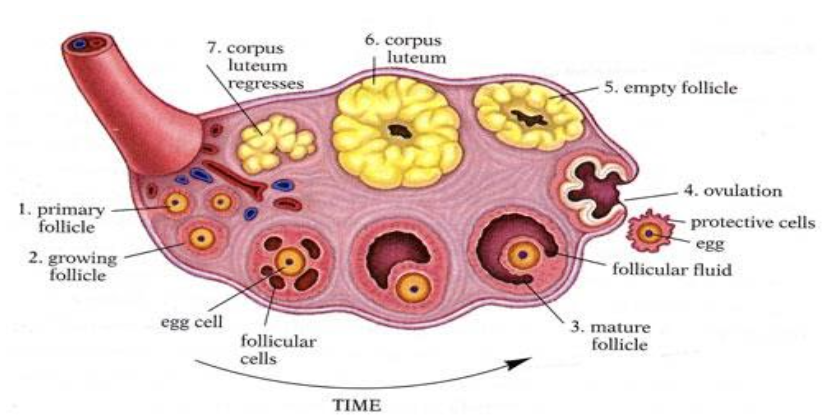
Describe the internal structure of the human ovary?
Answer
468.9k+ views
Hint: The ovary is an organ that is found in the female reproductive system that produces an ovum. When it gets released, it travels down to the fallopian tube into the uterus, where it may get fertilized by a sperm. The ovary is found on each side of the body.
Complete answer:
- The ovaries are female gonads. Each ovary is situated on each side of the lateral wall of the uterus in a region called the ovarian fossa.
- Ovaries are connected to the uterus through the fallopian tubes. This is covered by a layer of germinal epithelium.
- During the embryonic phase, the cells of the germinal epithelium proliferate into thousands of Primordial follicles.
- The cortex consists of thousands of minute immature ovarian follicles. Medulla has only blood vessels and nerve fibers.
- A completely mature ovarian follicle is known as the Graafian follicle. It consists of an outer multi-layered membrane granulosa. Membrane granulosa is made up of 2-3 layers of follicle cells.
- The oocyte is surrounded by a vitelline membrane, corona radiata, and zona radiata.
- The Graafian follicle contains a follicular cavity or antrum filled with a colorless fluid.
- In human females, after around 28 days one Graafian follicle matures and gets ruptures and thereby releases the ovum.
- Once the ovum is released it becomes the corpus luteum. It acts as a temporary endocrine gland by releasing female sex hormones progesterone and estrogen. Then it became corpus Albicans and disappeared.

Additional information:
At the time of puberty, the ovary starts secreting increasing levels of hormones. Secondary sex characters start to develop in response to the hormones secreted. Ovaries can regulate hormones and also play an important role in pregnancy and fertility. Ovaries are the site of production and periodically release of egg cells i.e. female gametes. Ovaries secrete inhibin, androgen, progesterone, and estrogen.
If in case the egg fails to release from the follicle in the ovary an ovarian cyst may form. Small ovarian cysts are common but if the number is more than usual it causes polycystic ovary syndrome which inhibits the follicles from growing normally and causes the irregularities in the cycle.
Note: The human ovary consists of the outer cortex, which consists of follicles, oocytes, and some interstitial cells. It also consists of the inner medulla which consists of additional interstitial cells, blood vessels, fibrous tissue, nerves, and lymphatic ducts. The human ovary is required in reproduction because it is responsible for the formation of female reproductive cells i.e. ova.
Complete answer:
- The ovaries are female gonads. Each ovary is situated on each side of the lateral wall of the uterus in a region called the ovarian fossa.
- Ovaries are connected to the uterus through the fallopian tubes. This is covered by a layer of germinal epithelium.
- During the embryonic phase, the cells of the germinal epithelium proliferate into thousands of Primordial follicles.
- The cortex consists of thousands of minute immature ovarian follicles. Medulla has only blood vessels and nerve fibers.
- A completely mature ovarian follicle is known as the Graafian follicle. It consists of an outer multi-layered membrane granulosa. Membrane granulosa is made up of 2-3 layers of follicle cells.
- The oocyte is surrounded by a vitelline membrane, corona radiata, and zona radiata.
- The Graafian follicle contains a follicular cavity or antrum filled with a colorless fluid.
- In human females, after around 28 days one Graafian follicle matures and gets ruptures and thereby releases the ovum.
- Once the ovum is released it becomes the corpus luteum. It acts as a temporary endocrine gland by releasing female sex hormones progesterone and estrogen. Then it became corpus Albicans and disappeared.

Additional information:
At the time of puberty, the ovary starts secreting increasing levels of hormones. Secondary sex characters start to develop in response to the hormones secreted. Ovaries can regulate hormones and also play an important role in pregnancy and fertility. Ovaries are the site of production and periodically release of egg cells i.e. female gametes. Ovaries secrete inhibin, androgen, progesterone, and estrogen.
If in case the egg fails to release from the follicle in the ovary an ovarian cyst may form. Small ovarian cysts are common but if the number is more than usual it causes polycystic ovary syndrome which inhibits the follicles from growing normally and causes the irregularities in the cycle.
Note: The human ovary consists of the outer cortex, which consists of follicles, oocytes, and some interstitial cells. It also consists of the inner medulla which consists of additional interstitial cells, blood vessels, fibrous tissue, nerves, and lymphatic ducts. The human ovary is required in reproduction because it is responsible for the formation of female reproductive cells i.e. ova.
Recently Updated Pages
Class 12 Question and Answer - Your Ultimate Solutions Guide

Master Class 12 Social Science: Engaging Questions & Answers for Success

Master Class 12 Physics: Engaging Questions & Answers for Success

Master Class 12 Maths: Engaging Questions & Answers for Success

Master Class 12 English: Engaging Questions & Answers for Success

Master Class 12 Chemistry: Engaging Questions & Answers for Success

Trending doubts
Which are the Top 10 Largest Countries of the World?

Differentiate between homogeneous and heterogeneous class 12 chemistry CBSE

Draw a labelled sketch of the human eye class 12 physics CBSE

What is a transformer Explain the principle construction class 12 physics CBSE

How much time does it take to bleed after eating p class 12 biology CBSE

What are the major means of transport Explain each class 12 social science CBSE




